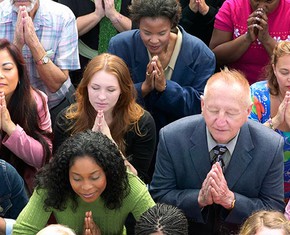The views expressed in our content reflect individual perspectives and do not represent the authoritative views of the Baha'i Faith.
The assurance of an afterlife is by itself hardly a sufficient reason to relinquish a fear of death, since few of us can be absolutely certain how well we have educated our spirit at that point.
The Baha’i writings clearly confirm the validity of such concerns. In numerous passages the initial stages of a negative experience at death are described, and the basis for this experience defined:
… they that live in error shall be seized with such fear and trembling, and shall be filled with such consternation, as nothing can exceed. – Baha’u’llah, Gleanings from the Writings of Baha’u’llah, p. 171.
The souls of the infidels, however, shall—and to this I bear witness—when breathing their last be made aware of the good things that have escaped them, and shall bemoan their plight, and shall humble themselves before God. They shall continue doing so after the separation of their souls from their bodies. – Ibid., pp. 170-171.
If it [the individual soul] be faithful to God, it will reflect His light, and will, eventually, return unto Him. If it fail, however, in its allegiance to its Creator, it will become a victim to self and passion, and will, in the end, sink in their depths. – Ibid., p. 159.
At first we might be tempted to consider that what Moody’s near-death experience subjects categorize as the consequences of “breaking the rules” might correspond to what Baha’u’llah designates in these passages with such epithets as “infidels,” “they that live in error,” and those who “become a victim to self and passion.” Yet these phrases hardly seem appropriate to those who, in despair or in the ravages of clinical depression, take their own lives. Furthermore, it is not at all clear from these passages what exactly Baha’u’llah means by such phrases as “infidel,” especially since there is nothing in the Baha’i writings to indicate that spirituality or godliness is conditioned on belonging to any particular group or adhering to any particular belief system.
Certainly it would appear that for God to provide only two alternatives—a positive experience for the spirituality elite and a negative experience for failures—is hardly more just or appropriate than the literal allusions to “heaven” and “hell” of other religions. Furthermore, this bifurcation of the afterlife experience is only slightly more just and logical than it might be if everyone received a uniformly blissful experience—since God’s ultimate purpose for us is not judgment, but the education and development of our souls as we gradually evolve through an ever more complete understanding of reality and act out that understanding in an ever more creative and selfless response to that knowledge.
So while there seems to be some relationship between one’s performance in the physical world and one’s continued progress in the next life—therefore giving an explicit meaning and purpose to the way we conduct our physical lives—it hardly seems appropriate that fallible souls should be condemned perpetually for mistakes made over a relatively short period within an eternal existence. Put another way, it seems improbable and inconsistent that a wise, just, and loving Deity would be incapable of making finer distinctions in judging us than creating only two possible responses to our performance in this initial stage of our existence, especially since no two souls are exactly the same and no two lives are identical. Surely a just and loving God is capable of making each afterlife experience fit precisely the unique exigencies that pertain to life of each soul.
Self-Judgment
We can begin to discern a more sophisticated, enhanced paradigm of the afterlife experience by examining what Moody himself discovered as he investigated further what had appeared only as an aberration of the model in his first work—the unpleasant experiences of the suicides. In Reflections on Life After Life, Moody presents several distinct categories of afterlife experiences, all of which differ dramatically from the pattern he emphasized in his initial study.
One such category is a variation on the “unpleasant limbo” model. This, too, is a negative experience, but it results from a sense of judgment that occurs during the panoramic replay. The subjects in this category do not seem to be in an explicitly negative environment, nor are they in the sort of “holding pattern” described by those in the “unpleasant limbo” state. However, they do seem to have committed enough negative acts—or to have omitted committing enough positive acts—that the replay of their lives makes them feel immense shame and guilt:
Then it seemed there was a display all around me, and everything in my life just went by for review, you might say. I was really very, very ashamed of a lot of the things that I experienced because it seemed that I had a different knowledge, that the light was showing me what was wrong, what I did wrong. And it was very real. – Raymond Moody, Reflections on Life After Life, pp. 34-35.
Moody himself speculates that a mode of experience most closely approximating the mythic hell of scripture might be this same model as experienced by someone who had perpetrated horrendous acts upon others. Moody notes importantly that the subjects he interviewed were, after all, guilty of only minor transgressions, and yet they experienced great remorse.
Moody thus surmises that were the emotions evoked by such a recounting proportionately greater for more grievous acts, he could imagine be no worse punishment than to go through such a review after having committed truly horrendous acts upon innocent victims:
If what happened to my subjects happened to these men, they would see all these things and many others come alive, vividly portrayed before them. In my wildest fantasies, I am totally unable to imagine a hell more horrible, more ultimately unbearable than this. – Ibid., pp. 38-39.
















Comments
Sign in or create an account
Continue with Googleor